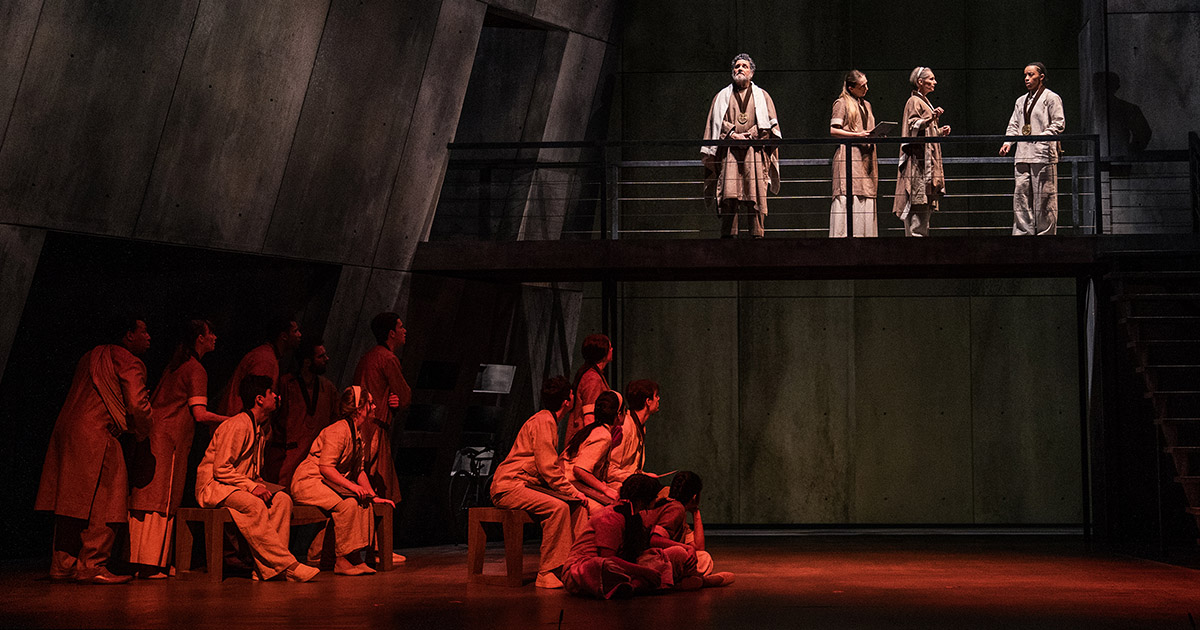If you are over the age of 40, you might not be personally familiar with the 1994 Newberry Medal winning novel by Lois Lowry, The Giver. Since its publishing in 1993, the book has been heaped with praise and is a wildly popular inclusion in middle school and high school curriculums. This intense popularity has led to a number of adaptations, including a 2014 film that starred Jeff Bridges, Meryl Streep, Alexander Skarsgård, Katie Holmes, and yes, Taylor Swift. The current Clarence Brown Theatre production of The Giver which opened last week, is a stage adaptation by Eric Coble that was commissioned and premiered by the Oregon Children’s Theatre in 2006.
Directed for CBT by Marti Gobel, this beautifully thought-provoking production describes a colorless dystopian “community” where the issues of discrimination, hunger, pain, and conflict have been solved by “sameness” — an existence that is devoid of choice, human love, sexual passion, and personal disagreements. It is a significant irony, in fact, that just such an empty society can provoke the opposite feelings in an audience. Gobel has also added an additional layer of nuance to the onstage communication mix, the selective use of American Sign Language to “underline” certain concepts in this dystopian world that are hypocritical euphemisms for certain subject matter.
The production skillfully defines the premise that “color is conflict” through visual and dramatic means, although there is really no such thing as “no color” in the tactile, textural world of the theatre. The production’s marvelous set by Michaela Lochen is a multi-functional suggestion of Brutalist architecture construction in monochromatic concrete—minimalism in texture, color, and angle. It takes the idea of visual metaphor to a new level.
The idea of color is first introduced by the main character Jonas (Jasmine R. Handy), a 12-year old child who has reached the age where the Community assigns one a life-long profession. [Interestingly, Handy is female, although that fact reflects CBT casting and Handy’s physical size and impressive range of acting ability rather than any particular reference to sexuality.] In an important ceremony, the Chief Elder (Tarah Flanagan) announces the Elders’ decisions about the future of the pre-teens. While his age-mates are assigned tasks like recreation supervisor, care-giver, or laborer, Jonas is chosen to be the Community’s new Receiver of Memory, the critically important vessel that carries emotions, experiences, and knowledge of the society so that the people are not burdened by the very things that would make them human.

David Cecsarini, making a notable CBT debut in the role of The Giver, exudes a strong and experienced presence as the holder of Memories—and hence wisdom—that his character must judicially pass on to Jonas. As the process of transferring memories proceeds, happy and pleasant memories are joined by horrific experiences and realizations. Jonas begins to learn the dark realities of the supposedly Utopian world—euthanasia and population control among them—that he has accepted to date. He learns, too, of the heartbreaking truth behind the failed process of The Giver’s previous Receiver, Rosemary (Yashashvi Choudhary), a fate that threatens him as well.

Jonas’ family unit and their interactions are so matter-of-fact that one could almost overlook the horror that passes for normality. As Father (Drew Drake) and Mother (Rachel Darden) play with Jonas and sister Lily (Allison Bunch) as any parents would, the conversation ultimately reveals that a baby they were nurturing—and even named Gabe—hasn’t met development standards by crying at night and will be “released” (euthanized) the following day.
In secondary roles, Jacob Leon and Jenna Mitchell are Jonas’ friends Asher and Fiona respectively. CBT veteran Carol Mayo Jenkins appears as Larissa and makes an important statement about elder care, an issue of population control in this Community.
Along with Lochen’s visual design, the idea of color and memories are given substance by carefully rendered video and projections, designed here by CBT artistic director Kenneth Martin. The bookcases representing memories come to life with color, ironically reminding us that the content of them can be endangered by those who seek to ban them. The designer-ly monochromatic costumes are by Lauren T. Roark; Lighting designer Mitch Wilson managed the notable job of selectively splashing color onto a minimalist canvas. Allison Burcher’s sound and effects were marvelously environmental.
Admittedly, I worried for a bit about whether the production is suitable for age 10+ pre-teens, but have concluded it probably is. There are important concepts here that are universal, although there is an added video depiction that is unsettling, even for adults. Nevertheless, the play will give any family unit plenty of things to talk about.






